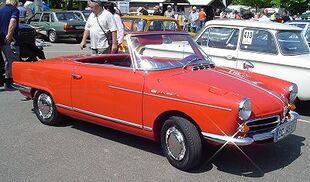Engineering:NSU Spider
| NSU Spider | |
|---|---|
 | |
| Overview | |
| Manufacturer | NSU Motorenwerke AG |
| Production | 1964–1967 2,375 built |
| Assembly | Neckarsulm |
| Designer | Bertone |
| Body and chassis | |
| Body style | 2-door cabriolet |
| Layout | RR layout |
| Powertrain | |
| Engine | 1.0 L KKM 502 (Wankel) |
| Transmission | 4-speed all-synchromesh manual |
| Dimensions | |
| Wheelbase | 2,020 mm (79.5 in) |
| Length | 3,580 mm (140.9 in) |
| Width | 1,520 mm (59.8 in) |
| Height | 1,260 mm (49.6 in) |
| |uk|Kerb|Curb}} weight | 700 kg (1,500 lb) (Measurements approximate) |

The NSU Spider is an automobile which was produced by NSU Motorenwerke AG from 1963 to 1967.[1]
The Spider was the first Western production car in the world to be powered by a Wankel rotary engine.[2] The water-cooled single rotor engine and standard front disc brakes differentiated the car from other cars of similar type of the period. The body was designed by Bertone.[3]
Body
First appearing in 1963,[4] the Spider featured a two-door cabriolet body based on that of the NSU Sport Prinz coupé introduced in 1959. In addition to the folding roof, the Spider was distinguishable from the hard top car by a grill at the front. As with all NSU cars at the time, the engine was rear-mounted: in order to improve weight distribution, space was found for the Spider’s radiator and for its 35-litre (9 US gal; 8 imp gal) fuel tank ahead of the driver. The front luggage locker was, in consequence, small. There was a second luggage area in the rear of the car above the engine.
Rotary engine
The NSU Spider is the first series production car powered by a Wankel rotary engine. In the Spider, a KKM 502 single-rotor engine with a single spark plug was used; it displaces 996 cm3 (61 in3) from a generating radius of 100 mm, a width of 67 mm, an eccentricity of 14 mm and an equidistant of 2 mm. Compression is 8.5, and the fuel required is petrol with an octane rating of 91 RON. The Spider's engine had "teething troubles", but is a compact, smoothly running engine with a decent power output. Rated power was initially 50 bhp (37 kW) at 5,500 rpm. In later models, rated power was 40 kW (54 hp) at 6,000 rpm. Maximum torque output is 79 N⋅m (58 lbf⋅ft) at 3,500/min, equivalent to a BMEP of 1 MPa (145 lbf/in2).[4] It was later found that the characteristics of critical materials selected and applied by NSU to build production rotary engines were inappropriate to the stresses they would bear, and rotary-engined cars earned a reputation for unreliability. Engines required frequent rebuilding to replace worn apex seals,and warranty costs associated with installation of the engine in NSU’s second Wankel-engined model destroyed the financial viability of NSU, forcing a merger with Audi in 1969.[5] The rotary engine was installed above the rear axle, being compact, light and free revving in comparison with conventional piston engines of the time. By ignoring the manufacturer's recommendations it was possible to rev the engine briefly above 7,000 rpm in the lower gears and thereby to achieve a 0 – 100 km/h (0 – 62 mph) time of 14.5 seconds: other sources, presumably based on following the manufacturer's recommendations, give a time of 15.7 seconds.
Commercial
Large sales volumes were never envisaged for the car, and this was reflected in a relatively high retail price, USD$2,979.[5] Between 1964 and 1967 2,375 were built. In 1967, the model was withdrawn and NSU's second rotary-engined production saloon was presented. The Ro 80, totaled 37,398 units during its ten year production run.
In 1966, Al Auger of Richmond, California, became the first person to race a Wankel-powered production car in an officially sanctioned race. After only installing a mandatory roll-bar and racing tires on an NSU Spider, Auger raced in 1966 and 1967 in Sports Car Club of America sanctioned road races throughout California finishing second overall in the championship both years in Class H Modified. Because SCCA had no technical information about the Wankel engine it was placed in H Modified racing against lighter, more powerful, 850 cc highly modified pure racing cars.
References
Notes
- ↑ nsu wankel spider 1964 at audi.com/corporate/en/company/history/models Accessed 28 December 2016
- ↑ "The Wankel Engine History". theautochannel.com. http://www.theautochannel.com/news/2004/07/04/202357.html. Retrieved 2008-02-21.
- ↑ "Classic drive - the 1966 NSU Spider". 19 December 2013. http://autoweek.com/article/car-life/classic-drive-1966-nsu-spider.
- ↑ 4.0 4.1 Bensinger, Wolf-Dieter (1973) (in de). Rotationskolben-Verbrennungsmotoren. Berlin, Heidelberg, New York: Springer. pp. 127–131. ISBN 978-3-540-05886-1. OCLC 251737493.
- ↑ 5.0 5.1 "The Rotary Club", Don Sherman, Automobile Magazine, February 2008, pp. 76–79
Bibliography
- Myhr, Claus (1989) (in de). NSU Ro 80 + Wankel Spider 1964–77. Schrader-Motor-Chronik, no. 35. München: Schrader Automobil-Bücher. ISBN 3922617492.
External links
 |

